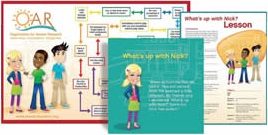Making The World A Better Place For Autistic Students
April 06, 2022
By: Christina Rodriguez, M.S.Ed., BCBA, and Ivan Deveaux , M.S.
“The worst thing you can do is nothing. ” ― Temple Grandin
Have you ever taken a subway at rush hour in a new city? Herds of people bump into you and loud noises are everywhere. Signs with information you need flash so quickly that they are indiscernible to you. It is overwhelming, and you are left breathless. You are not sure how to get someone’s attention for help, and even if you did, how would you communicate with them? For many autistic people, this is everyday life.
Over the past few years, schools, communities, and employers have liberally used the word “inclusion.” What exactly is inclusion? Oxford Languages defines inclusion as “the practice or policy of providing equal access to opportunities and resources for people who might otherwise be excluded or marginalized.” At first glance, this definition may seem like an appropriate representation of how to practice inclusion, but is it? If we are talking about people with special needs, is “equal” fair? Is “equal” enough?
For inclusion to be fair and enough, we cannot simply say something is inclusive. We cannot place a child in a general education class without accommodations. We cannot expect an autistic child to communicate without teaching the child how to do so. We must give them the tools and resources to even the playing field. We must learn and teach those around autistic children, especially their peers, how to not only accept but include autistic people.
At the University of Miami-Nova Southeastern University Center for Autism & Related Disabilities (UM-NSU CARD), a big part of what we do is educate people on neurodiversity and how to support neurodiverse people. Teachers, especially those who work in inclusive settings or general education settings, are in the best position to educate others on inclusion, compassion, and understanding. They can do that by telling, showing, and doing.
 We have used OAR’s Kit for Kids at UM-NSU CARD as the foundation for creating inclusive settings in our local schools, presenting its fun, interactive lessons to students in general education settings. It’s a free resource that any teacher can use to create interactive lessons to explain to students at their instructional level how people are different.
We have used OAR’s Kit for Kids at UM-NSU CARD as the foundation for creating inclusive settings in our local schools, presenting its fun, interactive lessons to students in general education settings. It’s a free resource that any teacher can use to create interactive lessons to explain to students at their instructional level how people are different.
For example, teachers can have students play a game of This or That. This for us has always been successful. The teacher may instruct the students to “stand up if you like chocolate ice cream and stay seated if you like vanilla.” After several examples, the teacher would point out that although people are different in their preferences, they can still be friends and respect each other. The teacher can follow this up by reading a book like “What’s up with Nick?” and then discussing it. It is likely that the students will have their own set of experiences outside of school and may be able to connect them to the story. The discussion is important, because talking about diversity is an important foundation for inclusion.
Lessons on inclusion should not stop with discussion, however. Teachers and caregivers have the opportunity to demonstrate and give opportunities to students to practice how to be inclusive. At UM-NSU CARD, for example, we use role playing and videos to show how neurotypical peers can be helpful in different situations. Scenarios we have used include helping with academic tasks and including both autistic and non-autistic peers in games, among others.
After the neurotypical peers receive instructional lessons and opportunities for practice, it is time to do. Teachers can now program for group work within their classes, create team building activities, and arrange group reinforcement contingencies. These exercises may increase the neurotypical peers’ level of understanding, ultimately resulting in more acceptance of the accommodations for the autistic student.
Whether you are an educator or a parent of an autistic person, you can use these ideas to promote inclusion in any group environment.
Accessibility: How a new environment, like a classroom, is set up plays a big role in a person’s ability to navigate that environment. To make navigating easier for an autistic person, consider presenting information and cues in the simplest way possible such as utilizing visual schedules or prompts. In addition, have a system for requesting information or assistance within that new environment. In doing so, you can maximize someone’s ability to demonstrate their skills. Allowing these opportunities can change the perception peers may have of autistic individuals.
Connectivity: The theme for this issue of The OARacle is interdependence, which happens to be a key aspect of inclusion. To promote interdependence, the place to start is with a conversation about strengths and weaknesses. From there, creating diverse teams composed of individuals with different skill sets can foster a supportive and respectful culture. In this context, peers accept, support, and celebrate each other in order to achieve a common goal. Safe environments promote open conversations which can lead to genuine, meaningful interactions. Learning this from a young age can promote higher levels of confidence and adaptability.
Self-Advocacy: Once the environment is accessible and there is a recognition of each person’s skills and talents, the last step is self-advocacy. Autistic people must be able to identify the areas in which they may need support and problem solve how to compensate for those. This is a key element for long-term success, especially as individuals move into less supported environments as they continue to grow and become more independent. Without self-advocacy there is no change. Who better than autistic individuals to help us identify how to be more inclusive?
Let’s go back to the subway station at rush hour. This time you know where you have to go, your headphones are on, you are listening to your favorite podcast, and you have learned which way to walk so that you don’t bump into so many people. You feel more comfortable, right? Why? You feel more comfortable because you have the proper understanding and the tools you need to navigate your environment. Placing yourself in that subway station was not enough.
Inclusion for the neurodiverse works similarly. To have inclusion, there must be:
Something to reflect on and remember is that autism is a spectrum. A one-time lesson or a one-time conversation will not be enough because autistic people are all different, as are we all.
 Christina Rodriguez, M.S.Ed., BCBA, is a case manager and a board-certified behavior analyst in the Applied Research and Behavioral Training Team at UM-NSU CARD. Besides her duties as a case manager, she also leads the Miami Dade County Neurodiversity Inclusion Initiative. Prior to working at CARD, she was a special education teacher for children with autism spectrum disorders in a self-contained classroom setting for over nine years. She has a master’s degree in special education with a specialization in autism spectrum disorders as well as a master’s degree in psychology with a concentration in behavior analysis.
Christina Rodriguez, M.S.Ed., BCBA, is a case manager and a board-certified behavior analyst in the Applied Research and Behavioral Training Team at UM-NSU CARD. Besides her duties as a case manager, she also leads the Miami Dade County Neurodiversity Inclusion Initiative. Prior to working at CARD, she was a special education teacher for children with autism spectrum disorders in a self-contained classroom setting for over nine years. She has a master’s degree in special education with a specialization in autism spectrum disorders as well as a master’s degree in psychology with a concentration in behavior analysis.
 Ivan Deveaux , M.S., is the manager of the Research and Behavioral Consultation and Outreach Services division at UM-NSU CARD. He has provided consultation services for parents, teachers, and professionals and has spoken at various conferences at the regional level. Prior to working at UM-NSU CARD, he worked with individuals with autism implementing behavioral strategies, providing instruction in a special education classroom, and supporting adults within their employment. In addition, he has a master’s degree in psychology with a concentration in applied behavior analysis from the University of Miami. He is currently pursuing certification from the Behavior Analysis Certification Board.
Ivan Deveaux , M.S., is the manager of the Research and Behavioral Consultation and Outreach Services division at UM-NSU CARD. He has provided consultation services for parents, teachers, and professionals and has spoken at various conferences at the regional level. Prior to working at UM-NSU CARD, he worked with individuals with autism implementing behavioral strategies, providing instruction in a special education classroom, and supporting adults within their employment. In addition, he has a master’s degree in psychology with a concentration in applied behavior analysis from the University of Miami. He is currently pursuing certification from the Behavior Analysis Certification Board.